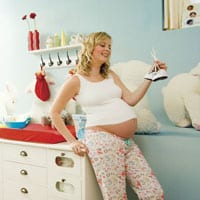Creating a safe and comfortable home for your new baby begins with her nursery. But where to start? If you have a clean slate to work with, first consider the room’s layout.
Organize your nursery space based on practical considerations such as temperature, natural light and ventilation. Is her crib near a draft? Do you need room-darkening blinds? As one of the largest and most important items in the room, first figure out where to place her crib, and map everything else from there. Then consider how the rest of the space will be used: Are you going to trip over anything carrying baby from crib to changing table?
Keep it Simple
It’s tempting to buy bundles of cute toys and accessories but remember that you’ll need to keep baby’s room tidy. No matter how much stuff you think a baby needs, you’ll end up with more! Consider building a baby closet with stacked shelving and built-in drawers, especially down low, where baby will one day be able to stash her toys away herself.
Keep a small, manageable toy box out for baby and hold the rest in storage; swap them every few months and baby thinks she gets new toys!
Delegate
If you’re pregnant, the AAP recommends that you avoid removing old paint or painting a room. Because paints before 1970 included lead and mercury, removing old paints is particular risky for you and baby. If you have to do the painting yourself, buy a safer “low VOC” paint, wear protective clothing and keep the area well ventilated.
Safety Checklist
When in the throes of nursery design don’t forget the safety considerations:
- Make sure your crib meets federal guidelines:
- Buy a nursery thermometer; babies who get too hot are at risk of SIDS: 65ºF is just right.
- Wind or cover all blind and electrical cords in baby’s room, especially near the crib or changing table.
- Install a smoke alarm in the nursery, and on every level of your home.
- Secure all furniture to the wall to prevent tipping.
- Install baby-proof electrical socket covers.
- Make “green” choices for a healthy nursery—see our eco nursery tips here.






Comments are closed.